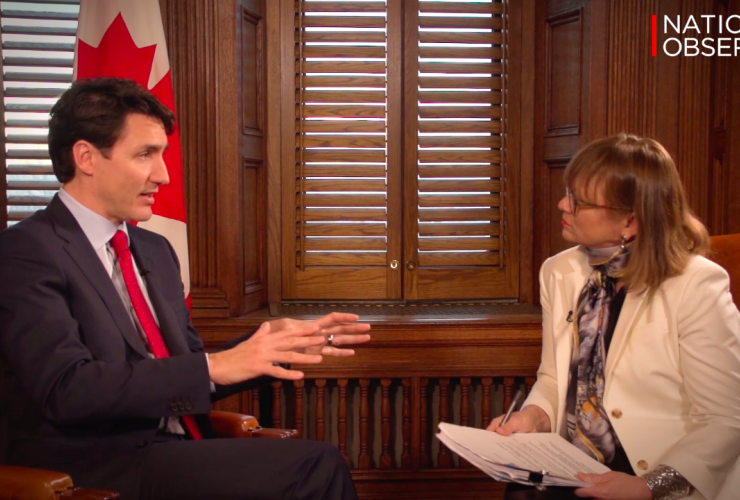Two weeks ago, the first supertanker capable of holding two million barrels of oil departed for the first time from America’s newly upgraded—and only—terminal able to dock and load crude-carrying behemoths of this size. Bound for China, the inaugural run signals a major shift in global oil shipping patterns, economics, and the highly competitive oil refinery business.
It is no accident that the Louisiana Offshore Oil Port (LOOP), terminal was built deep in the Mississippi Delta. To the south, a 29-kilometre pipeline stretches across the shallow Gulf of Mexico coastal shelf, to a point deep enough to allow Very Large Crude Carriers (VLCCs) to unload or load their vast tonnages of oil. Just north of Port Fourchon, an underground complex of salt caverns and surface tanks stores both oil imports headed for U.S. refineries, and fast-increasing volumes of oil bound for export.
The LOOP terminal is a speculator’s venture on steroids. Built with private capital, it is North America’s first oil port dedicated to the planet’s largest crude tankers, handling bi-directional oil flows. It’s designed to thrive on fierce global fights over not just oil supply and demand, but the multi-billion dollar bets corporate oil traders and hedge funds place, hoping to buy low and sell high—now, or two or five years from now.
Any VLCC from any country can now unload or load at LOOP. They can bring oil from the Persian Gulf, Nigeria, Russia, or Brazil. They can carry it—two million barrels at a time—to China, India, Indonesia, or Europe, at a shipping price lower than smaller tankers. And because the LOOP bi-directional pipeline can pump oil at a mind-bending 100,000 barrels per hour, supertankers can arrive with one load for refining and take off with another, by barely dropping anchor.
That will likely prove fatal to Alberta’s plans to expand unrefined bitumen exports either by the proposed Trans Mountain pipeline to the British Columbia coast, or the proposed Keystone XL pipeline because:
• Potential foreign refiners and customers will demand that future oil price, quality, shipping costs, and delivery speeds match those that LOOP can offer.
• For marine safety reasons, the maximum oil tanker cargo allowed through B.C.’s Burrard Inlet is an Aframax class ship at 80 per cent capacity carrying 550,000 barrels, only about one-quarter the load of a VLCC. That means a refiner in Asia would need to book and pay for four tankers to ship the same amount as from the LOOP terminal, then wait longer for the full order to arrive.
• The diluted bitumen Alberta wants to export has chemical and combustion properties that make it far inferior to the higher-quality oil LOOP has access to from U.S. formations in the Dakotas and Texas, or OPEC countries, or North Sea producers. Tar sands/oil sands bitumen can be upgraded and refined, but that adds significant costs and requires dedicated facilities.
• The terminus of the Keystone XL will be refineries on the Texas Gulf Coast near Houston which are not connected to the LOOP. Even if future Alberta bitumen were to be refined there, it would take three fully-loaded Aframax tankers leaving Texas for ship-to-ship transfers to each VLCC.
These important changes in tanker and terminal technology and scale are no secret in the oil industry outside Canada. Nor is the dirty chemical composition of tar sands/oil sands bitumen. Nor is the cutthroat competition among global oil producers, refiners, shippers, and speculators, in which nickels per barrel of oil delivered are fought over fiercely.
In fact, the bad news for Alberta’s oilpatch has been building for a decade. That’s when shipbuilders in South Korea, China and Japan began constructing what has become a global fleet of about 750 VLCCs (with 50 more ordered for 2018), and the scrapping of Aframax class tankers began accelerating. This in turn drove down the benchmark price for ocean oil shipping, triggered the LOOP terminal upgrade, effectively consigned oil terminals like those in Burnaby, B.C. to minor league status, and left oil deposits far from deep port tidewater at a significant cost disadvantage.
When the undeniably dirty content of Alberta’s bitumen deposits is added into these negative cost equations, global oil players know when to cut and run. Compared to conventional heavy crude, bitumen contains 102 times more copper, 21 times more vanadium, 11 times more sulphur, 11 times more nickel, six times more nitrogen, and five times more lead, according to the U.S. Geological Survey. It also has a much lower ratio of hydrogen to carbon, which degrades combustion efficiency.
This helps explain why, in the recent past, oil giants such as Exxon-Mobil, Conoco-Phillips, Royal Dutch Shell, Total S.A., and Norwegian oil company Statoil have abandoned gargantuan bitumen deposits in western Canada and/or taken billion-dollar write-downs, to the howls of shareholders.
For environmentalists and climate scientists, the chemical composition of Alberta bitumen is cause for deep worry about toxic air emissions, potential spills into waterways and aquifers, and further destabilizing the Earth’s precarious climate. Together with First Nations, they have vowed to fight long and hard for ecological reasons.
But for potential foreign purchasers of that oil, the key question is how much extra it will cost to extract the dirty chemical compounds in Alberta bitumen so that the quality is on par with export oil being produced at high-grade, low-cost shale formations like the Bakken, Permian, and Eagle Ford in the United States.
No refiners will pay the same price to process sweet light crude and bitumen because they have to make costly capital outlays to configure their refineries to extract higher sulphur and heavy metals like copper and lead, make up the hydrogen deficit of bitumen, then dispose of the mountains of chemical crud left over. So refiners—anywhere on the planet—will charge Alberta producers more to process each barrel of bitumen.
These facts are readily evident to those at the back end of the global oil supply chain. Alberta’s huge oilsands deposits cost too much to dig up, refine, and ship. They are in the wrong place, far from tidewater. And they rank among the dirtiest to refine into gasoline, aviation fuel, or home heating oil.
These are the reasons—hiding in plain sight—why Western Canada bitumen fetches the infamous “discount” price per barrel compared to oil supplies shipped from Texas and the North Sea. The LOOP terminal for VLCCs will magnify that spread, and no mythical Asian refiner, trader, or nation is likely to purchase for long a dirtier product that costs more and arrives on slower, smaller boats.
*******
Such details are apparently irrelevant to Alberta Premier Rachel Notley and her federal oilsands ally, Prime Minister Justin Trudeau. Instead, they seem to be choreographing a long con political gambit premised on blithe assurances that the optimal way to cut Alberta carbon emissions is to increase oilsands output by 40 per cent in the next 12 years.
You read that right. The oft-repeated “hard cap” the premier and prime minister publicly promote is a con. Alberta’s official energy plan is to increase oilsands emissions from 70 to 100 megatonnes per year by 2030.
That 30-megatonne increase is roughly equal to the annual greenhouse gas emissions from all the cars, trucks, buses, and boats currently used by 14 million people in Ontario. Put another way, by 2030 Alberta’s annual extra oilsands emissions will be equal to importing an Ontario’s worth of vehicle GHGs each year thereafter. For decades.
The Notley/Trudeau tag team, of course, would not put it this way. They’ve deployed a sly lexicon of euphemisms to help sell what can likely never be sold to actual foreign oil purchasers. A 40 per cent oilsands expansion is solemnly christened a “hard cap”, in the manner of two drunks who vow to stay sober once their annual booze binge hits that higher limit.
Dirty bitumen becomes a “product” or a “resource”. How sanitary. Blowing a hole in Canada’s national carbon budget as pledged under the Paris climate agreement becomes a “nation-building” crusade. A tax to help cut carbon pollution is a brave, virtuous policy—but only if oilsands output can accelerate, and the tax rate is carefully calibrated to not put a dent in that. Fossil producers must pay royalties to help a debt-laden province—but are allowed to pay in barrels of raw bitumen instead of cash.
Perhaps this is normal political chicanery. It echoes Donald Trump’s campaign vow to bring back “clean” coal. That con may have garnered enough key electoral college votes to win the U.S. presidency, but major U.S. coal producers are now going bankrupt because the world price has plunged and utilities in the U.S. and elsewhere have found cheaper, cleaner ways to generate power.
Recently, Notley and Trudeau have begun to publicly warn that the very fate of Canada rests on future oilsands output; that the pending national carbon plan might be shattered if Alberta is not allowed to export billions more barrels of bitumen via two pending export pipelines; and that the Constitution would be sabotaged by any premier who failed to deliver unquestioned fealty to their grand vision.
But what if that’s all just a fiscal fantasy? Or worse, a fraud?
That question may seem unthinkable—even treasonous—in the political capitals of Ottawa and Edmonton. But it is being asked in Big Oil boardrooms in Houston and Paris, by national oil entities like Norway’s Statoil, by oil traders in London and New York, and by refinery operators in the U.S. and Asia. By people who, for better or worse, know how and where global oil will be made, bought, sold, and shipped in the next decade, and where a buck will best be made.
About 20 months ago, many of the Big Oil players began to cut their losses and quietly stampede away from the Alberta oilsands. Many bought into shale oil plays in the Dakotas and Texas.
Then Washington repealed a 40-year ban on the export of oil drilled by producers within the United States. Suddenly, Americans could sell to Asia and Europe. Countless more shale wells were drilled, American pipelines began filling to capacity, and high-quality crude began flowing faster to Texas and Louisiana refineries on the Gulf Coast.
By the end of 2017, U.S. oil production was at an historic high, vast storage tank farms were full, and even major OPEC countries—reeling from the tsunami of oil coming from their new American competitor—tried to shore up world prices by cutting production and selling premium blends at deeply discounted prices to Asian and U.S. customers.
Iran, Iraq, and Venezuela undercut that by increasing oil exports at rock bottom prices. China, oil traders, and hedge funds swooped in to buy unprecedented volumes of high-quality, low-cost oil to build inventories or store in VLCCs hunkered down in harbours across the globe. (That fleet of 750 supertankers could collectively store some 1.5 billion barrels of oil at any given time.)
That created a new normal which is likely to last for the foreseeable future, and spell disaster for any future Alberta tar sands/oil sands expansion. Like their competitors in the Persian Gulf, American shale oil producers can drill deposits quickly and cheaply, then tap or cap them depending on the transient price of oil. Some can survive at US$20 per barrel. Most need $40 to justify pumping and selling for a profit.
That has made American shale producers arch rivals of the Alberta oilpatch, where anticipated new projects require huge capital investments that can only be recouped over decades of unrelenting and profitable oil production. A consensus estimate of the world oil price needed to make that happen is US$80 to 100 per barrel. It is nowhere on the horizon.
By contrast, a minor swing in oil prices can cause a VLCC to change course mid-ocean and head for a new customer offering a better price. How could a new oilsands project be bankrolled when such price volatility is the new normal, and decades-long contracts are ancient history? It can’t.
This brings us back to the question of whether Premier Notley and Prime Minister Trudeau are merrily tripping the light fantastic upon hopes of a fossil revival, or practicing the darker art of deception. If serial failures to conduct even basic due diligence on global oil trends is a decisive clue, it is the latter.
There is no business case for an expansion of Alberta’s oilsands on the scale needed to justify the Keystone XL and Trans Mountain export pipelines because of one bare fact: there are zero foreign buyers who today will commit to decades-long purchase contracts for unrefined bitumen at a fixed price near US$80 per barrel. Instead, global traders will literally buy future oil by the boatload, then book terminal time at any deepwater ocean port like the LOOP, anywhere in the world, to embark with two million barrels in a single cargo.
Vancouver will never be one of those ports. No VLCC will ever arrive to offload foreign oil, then upload Alberta bitumen for a backhaul trip to foreign refineries. So the pending Trans Mountain pipeline plan to triple oilsands exports, and increase oil tanker traffic under the Lions Gate Bridge up to seven-fold, is doomed. So is the plan to expand oilsands output by 40 per cent. No amount of cheerleading, or demonizing, or pixie dust will change the raw laws of global oil economics.
Down deep in the Mississippi Delta, near the LOOP oil terminal which will likely never transfer a barrel of Alberta bitumen for export, Bayou bar parlance might sum up that fate with the laconic one-liner: “That dog won’t hunt.”
If only Premier Notley and Prime Minister Trudeau could match such penetrating clarity.
Paul McKay is an award-winning investigative reporter and author. His reports have been published by the Ottawa Citizen, Toronto Star, Globe and Mail, and Vancouver Sun. He can be reached at [email protected]. This piece was published first on Energy Mix.
The fact that it is
The fact that it is uneconomical for Kinder Morgan to ship Alberta crude oil to foreign countries other than the U.S. means that the oil carried by the TransMountain pipeline (if built) will end up (as it is now) in refineries on the U.S. west coast. That would allow those refineries to substitute heavy crude oil coming from Mexico and Venezuela (both have been in decline over the years). The other advantage would be to free more crude oil coming from Alaska, giving Alaska's oil producers the possibility to ship their crude to Asia where they can get a better price (port facilities in Valdez Alaska are also accessible to VLCCC).
So, as said in his article, there is essentially no chance for Canadian oil producers to be able to compete on the world market. American oil producers are already aggressively trying to get their share of the world oil market. The only market for Canada's heavy crude oil is the U.S. (Canada export some oil to other countries consisting entirely of light crude oil produced in Eastern Canada)
One more little note: How come premier Notley and the CAPP argue that Alberta oil producers can't expand their business because of a lack of pipelines while TransCanada can't get enough shipment commitments from oil producers to allow the construction of the Keystone XL. The Alberta government, which royalties are partially paid with oil instead of money, has committed some of these oil reserves (a 20 year commitment) to help TransCanada. This is just another way to subsidize the oil and gas industry which already get billions of dollars from different level of governments.
The lack of a business case
The lack of a business case has been well stated here. The lack of an environmental case for increased oil sands and fracking activities is even more compelling. Alberta and Canada are fiddling while the Earth burns, and we will all suffer if this blindness continues.
Compared to conventional
Compared to conventional heavy crude, bitumen contains 102 times more copper, 21 times more vanadium, 11 times more sulphur, 11 times more nickel, six times more nitrogen, and five times more lead, according to the U.S. Geological Survey.







Comments